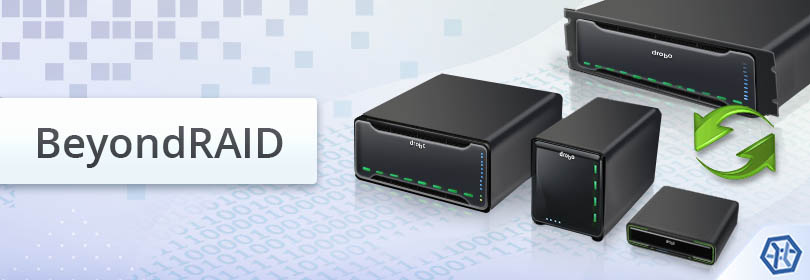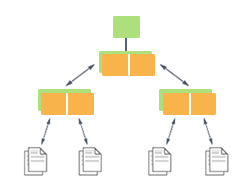Drobo's BeyondRAID overview: What does it offer against data loss?

Over the decades of RAID, the technology has undergone drastic changes and improvements. In the attempt to balance between performance, capacity and reliability, developers have created new levels, new features and new opportunities.
Apart from RAID 0 and JBOD, RAID has always been associated with safe data storage. Redundancy, parity and hot spare are just the terms related to RAID techniques which provide data safety.
First implemented as a storage solution for big enterprises, RAIDs appeared to have numerous advantages, so they have easily gained popularity among small businesses and home users. Yet, the latter had little time and knowledge to gain insight into all fine points of RAID, to choose the right balance between useful storage capacity, system reliability and its overall cost. A new BeyondRAID solution developed by Drobo has gone beyond any limitations and relieved the strain from the need to choose.
Hint: All the basic RAID concepts are described in the peculiarities of data organization on RAID.
BeyondRAID: specifics and advantages
The main idea behind BeyondRAID was creating a storage system that would be easy to manage and that would surpass usual barriers imposed by dependence on a RAID level. Certainly, with BeyondRAID, the technology underwent improvements in performance and safety of data storing.
-
Self-management. The major feature of the BeyondRAID system is its self-management. Balancing between efficiency, fault-tolerance and capacity provision, flexible BeyondRAID chooses its own strategy for writing data to the drive at any given moment. Thus, you don’t have to think about the RAID level before using the storage.

-
Data awareness. BeyondRAID creates a Data Allocation Table to keep track of the file chunks stored on the device. The table contains information concerning properties, physical drives and a data distribution pattern of each data chunk. For enhanced security, the table is created in more than two copies. If any of the data chunks gets corrupted, the system immediately recovers it.

-
Copy-on-Write (CoW). In its policy of data modifications, BeyondRAID applies the Copy-on-Write method. Any changes to a file are made with the creation of a new copy and a link (or path) to the older file version. This method ensures successful data recovery, as several copies of the same file can still remain on the BeyondRAID storage.

-
Thin provisioning. Targeted at maximum efficiency, BeyondRAID applies thin provisioning, using the whole storage pool for writing data. This allows allocating exactly the right amount of disk space for storing data at any given moment of time and eliminating wasted disk space.

-
Smart Volumes. A Drobo based on BeyondRAID gives a total of 64 TB (or 16 TB with older firmware) of virtual disk space. However, LUNs can be of different sizes irrespective of the amount of the physical drives’ capacities available in the storage. Creating a new logical unit does not require specially allocated physical space. A new LUN would rather take the exact amount of storage space from the common pool it needs at any given moment of time. Moreover, if the disk space is cleaned, the volume gives it back to the common pool for writing new data.

-
Zero-click iSCSI protocol. There is an iSCSI protocol in Drobo BeyondRAID storages that fits both Windows and macOS servers.
BeyondRAID vs. traditional RAID
Traditional RAIDs have such unpleasant side effects as the necessity to insert drives of the same size, with the same specifications and performances only, the obligation to choose a RAID pattern beforehand, and the lack of opportunity to change RAID configuration without losing data. BeyondRAID leaves behind dozens of questions about RAID storages, allowing even unskilled users to benefit from a RAID storage.
Check out the table below to learn the difference between RAID and BeyondRAID.
| Traditional RAID | BeyondRAID |
|---|---|
|
Strict requirements to the drive’s size. If drives of different sizes are inserted into RAID, the system assigns the size of the smallest drive to the array. Thus, the space beyond the smallest drive’s size limit will be wasted. |
No requirements to drives’ sizes.The system efficiently utilizes and distributes the data across the total drives’ capacity. |
|
Strict requirements to technical specifications. If specifications differ, the system might not work. |
No requirements as to drives’ characteristics. You can use any working drives you prefer. |
|
Strict requirements to the drives order. If the drives' order is changed, the system is not able to read the data. |
Easy drive re-ordering. The system reads data irrespective of the order. |
|
RAID level. You must decide what RAID level you prefer before the system is configured. You will often have to choose between the capacity, performance and resilience. |
No such term as RAID level. The system efficiently distributes the data, choosing the most optimal data distribution pattern for each certain data writing. You only choose if you want a single or a dual-disk redundancy. |
|
Unchangeable data distribution pattern and the number of drives. Changing RAID configuration as well as adding more drives may cause data loss. |
The flexible and easily expandable system. It allows changing a data distribution pattern and adding drives without any threat of data loss. |
|
Idling reserve drive. A spare drive just exists in the system and waits idly until another drive in the storage fails. |
Virtual reserve drive. A drive intended to replace a failing drive is used in the system all the time. If the system happens to collapse, it will be reconfigured in a way to protect data from loss without disruptions and downtimes. |
BeyondRAID still loses data
Despite all enhanced security features and its smartness, a BeyondRAID storage is still exposed to failures causing data loss. If you are experiencing data loss from a BeyondRAID storage, you can come up against one of the following problems:
- Failures in the process of updating Drobo software
- Overshooting failures
- Need to replace more than one drive with a reserved one
Beyond RAID and data recovery
In view of the peculiarities of data distribution on BeyondRAID, data recovery from such arrays is a complex operation which requires sophisticated software techniques available only in the Professional, RAID and Network RAID editions of UFS Explorer. For this procedure you will also need:
- a computer running Windows, Linux or macOS on which the software will be launched;
- an internal, external or network storage large enough to place the recovered data;
- SATA cables and vacant ports on the motherboard to connect the drives to a PC. USB-to-SATA adapters, external enclosures or expansion cards can be employed as well.
Hint: Please consult the instructions to safely remove the drives from your NAS and connect them to the computer for data recovery.
The software automatically detects the BeoyndRAID volume metadata present on the NAS drives and the array can be reassembled as BeoyndRAID from the recognized volumes as described in the tutorial on data recovery from Drobo.
The setup may also feature a supplementary mSATA SSD module operating as Drobo Accelerator Cache. In case of an improper shutdown of the appliance, hardware failure or other issues, critical frequently accessed data may be left in the cache, without being transferred to the primary array. The entire configuration then should be processed in the program in accordance with the instructions for Drobo with enabled mSATA cache.
However, if you have issues or cannot perform the procedure by yourself, please, feel free to contact our technical specialists.
Last update: May 19, 2023
